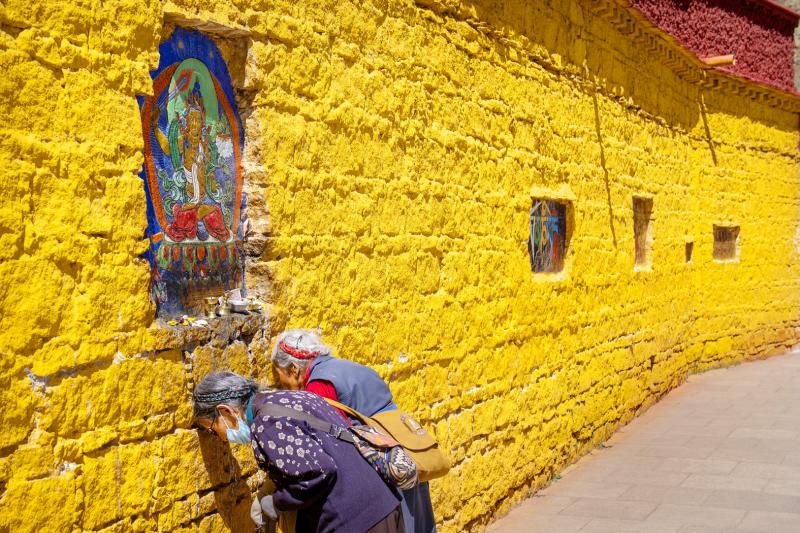The name Tibet conjures up images of snowy peaks, vermillion temples and prayer flags snapping in the Himalayan wind. Those features remain, but the religious and cultural foundations underpinning them appear to be coming unstuck.
Long defined by its Buddhist culture, the region is facing a push for assimilation and political orthodoxy under China’s ruling Communist Party. Tibetans and other minorities are seeing the use of their languages downgraded in schools and old ways of living eroded for the promise of better quality of life through mobile phones, online shopping, higher education and improved health care.
Political conformity is enforced through relentless surveillance of people’s social interactions in actual life and online. Religious practices that once dominated the region have been excised from daily living and the aging Dalai Lama, the spiritual leader of Tibet who has lived in exile since 1959, is portrayed as a figure of scorn, when he’s even acknowledged at all.

Photo: AP
Chinese tourists have flocked to Lhasa, the capital, and it’s environs, despite the high altitude that requires many to rely on canned oxygen. They mix with Tibetans making rare pilgrimages that include devotional laps around Jokhang Temple, the cathedral of Tibetan Buddhism.
A must-go spot for visitors is the stone-paved square at the base of the Potala Palace, the former home of the Dalai Lama and his predecessors that is now a museum. As tourists pose and college graduates use it as a backdrop for class photos, its inert status serves as a reminder of the political issues enveloping Tibet.
Over the centuries, Tibet evolved from a collection of kingdoms to something like a unified state that accepted suzerainty under successive Chinese imperial dynasties that ruled until 1912. Full Chinese control came after the Communist Party took power in 1949 and sent troops to overcome Tibet’s feeble defenses in 1951.
The government says it has brought development to a region long left behind. Critics say the exploitation of Tibet’s natural resources, environmental degradation and an influx of migrants from China’s majority Han ethnic group cannot be sustained.
Lhasa has seen a burst of new construction, nomads have been settled in model villages and the military’s presence has been boosted to assert China’s claim to territory held by India, with whom China last year came to blows over their disputed frontier on Tibet’s southern border.
On a rare government-led tour of Tibet, journalists saw modernization of highways and a railway to the Chinese heartland, schools that teach in Chinese under portraits of Chinese leader Xi Jinping (習近平) and signs of an emerging urban middle class including both Tibetans and Han Chinese.
Under myriad pressures, Tibet’s identity faces possibly the greatest threat in its history. Like the flapping prayer flags, its fate lies in the wind.

In the March 9 edition of the Taipei Times a piece by Ninon Godefroy ran with the headine “The quiet, gentle rhythm of Taiwan.” It started with the line “Taiwan is a small, humble place. There is no Eiffel Tower, no pyramids — no singular attraction that draws the world’s attention.” I laughed out loud at that. This was out of no disrespect for the author or the piece, which made some interesting analogies and good points about how both Din Tai Fung’s and Taiwan Semiconductor Manufacturing Co’s (TSMC, 台積電) meticulous attention to detail and quality are not quite up to

April 21 to April 27 Hsieh Er’s (謝娥) political fortunes were rising fast after she got out of jail and joined the Chinese Nationalist Party (KMT) in December 1945. Not only did she hold key positions in various committees, she was elected the only woman on the Taipei City Council and headed to Nanjing in 1946 as the sole Taiwanese female representative to the National Constituent Assembly. With the support of first lady Soong May-ling (宋美齡), she started the Taipei Women’s Association and Taiwan Provincial Women’s Association, where she

Chinese Nationalist Party (KMT) Chairman Eric Chu (朱立倫) hatched a bold plan to charge forward and seize the initiative when he held a protest in front of the Taipei City Prosecutors’ Office. Though risky, because illegal, its success would help tackle at least six problems facing both himself and the KMT. What he did not see coming was Taipei Mayor Chiang Wan-an (將萬安) tripping him up out of the gate. In spite of Chu being the most consequential and successful KMT chairman since the early 2010s — arguably saving the party from financial ruin and restoring its electoral viability —

It is one of the more remarkable facts of Taiwan history that it was never occupied or claimed by any of the numerous kingdoms of southern China — Han or otherwise — that lay just across the water from it. None of their brilliant ministers ever discovered that Taiwan was a “core interest” of the state whose annexation was “inevitable.” As Paul Kua notes in an excellent monograph laying out how the Portuguese gave Taiwan the name “Formosa,” the first Europeans to express an interest in occupying Taiwan were the Spanish. Tonio Andrade in his seminal work, How Taiwan Became Chinese,